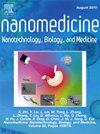透明质酸纳米凝胶包封提高了蛇抗菌素Ab-Cath的选择性指数。
IF 4.2
2区 医学
Q2 MEDICINE, RESEARCH & EXPERIMENTAL
引用次数: 1
摘要
抗菌肽Ab-Cath是一种很有前途的候选药物,可用于治疗抗生素耐药(AMR)细菌感染。由于Ab-Cath的阳离子多肽性质和有限的治疗窗口,未来的临床应用受到阻碍。在这里,我们评估了透明质酸纳米凝胶用于Ab-Cath的包封,以规避这些限制。采用微流体技术制备了单分散阴离子纳米凝胶,其粒径为156 ~ 232nm,包封率> 99%的Ab-Cath。前所未有的,使用聚乙烯醇和葡聚糖-40的冻干提供了Ab-Cath纳米凝胶保护,并允许轻松调整剂量。冻干和再分散的Ab-Cath纳米凝胶与Ab-Cath溶液在杀死生物体液中的AMR金黄色葡萄球菌、鲍曼不动杆菌和大肠杆菌以及减少金黄色葡萄球菌和鲍曼不动杆菌生物膜方面的效果相同。重要的是,在纳米凝胶中包封Ab-Cath可将Ab-Cath对人成纤维细胞的细胞毒性作用降低≥10倍。此外,皮肤应用Ab-Cath纳米凝胶可以消除定植在3D人体皮肤上的细菌。这些发现证实了纳米凝胶的使用可以提高抗菌肽的选择性指数。本文章由计算机程序翻译,如有差异,请以英文原文为准。
Encapsulation into hyaluronic acid-based nanogels improves the selectivity index of the snake cathelicidin Ab-Cath.
The antimicrobial peptide Ab-Cath, is a promising candidate for development as treatment for antimicrobial resistant (AMR) bacterial infections. Future clinical use is hampered by Ab-Cath's cationic peptidic nature and limited therapeutic window. Here, we evaluated hyaluronic acid-based nanogels for encapsulation of Ab-Cath to circumvent these limitations. Using microfluidics, monodispersed anionic nanogels of 156 – 232 nm encapsulating >99 % Ab-Cath were prepared. Unprecedented, lyophilization using polyvinyl alcohol and dextran-40 provided Ab-Cath nanogel protection and allowed easy dose adjustment. Lyophilized and redispersed Ab-Cath nanogels were as effective as Ab-Cath solution in killing AMR Staphylococcus aureus , Acinetobacter baumannii and Escherichia coli in biological fluids, and in reducing S. aureus and A. baumannii biofilms. Importantly, encapsulation of Ab-Cath in nanogels reduced Ab-Cath's cytotoxic effects on human fibroblasts by ≥ 10-fold. Moreover, cutaneous application of Ab-Cath nanogels eliminated bacteria colonizing 3D human skin. These findings affirm the use of nanogels to increase the selectivity index of antimicrobial peptides.
求助全文
通过发布文献求助,成功后即可免费获取论文全文。
去求助
来源期刊
CiteScore
11.10
自引率
0.00%
发文量
133
审稿时长
42 days
期刊介绍:
The mission of Nanomedicine: Nanotechnology, Biology, and Medicine (Nanomedicine: NBM) is to promote the emerging interdisciplinary field of nanomedicine.
Nanomedicine: NBM is an international, peer-reviewed journal presenting novel, significant, and interdisciplinary theoretical and experimental results related to nanoscience and nanotechnology in the life and health sciences. Content includes basic, translational, and clinical research addressing diagnosis, treatment, monitoring, prediction, and prevention of diseases.

 求助内容:
求助内容: 应助结果提醒方式:
应助结果提醒方式:


